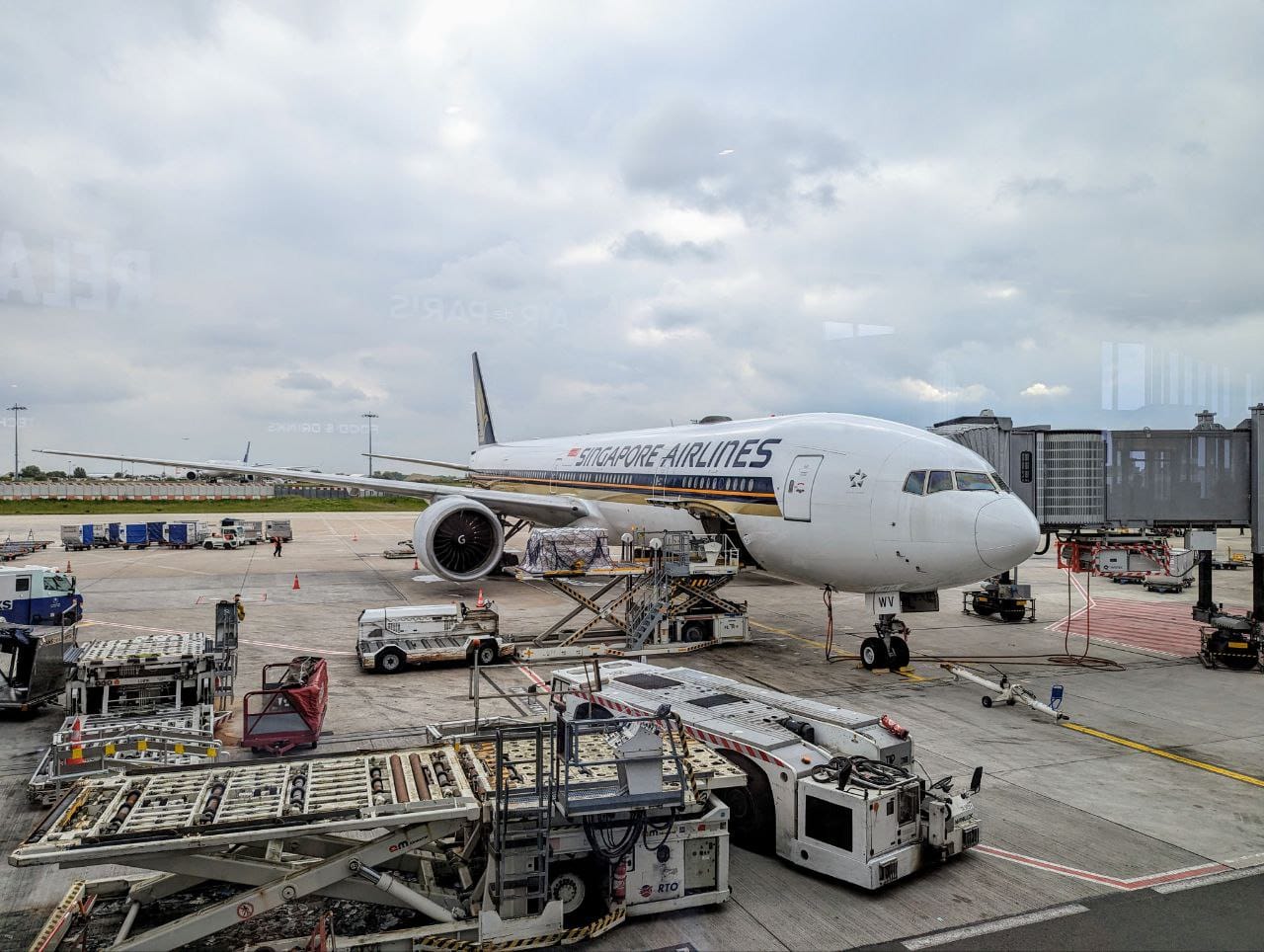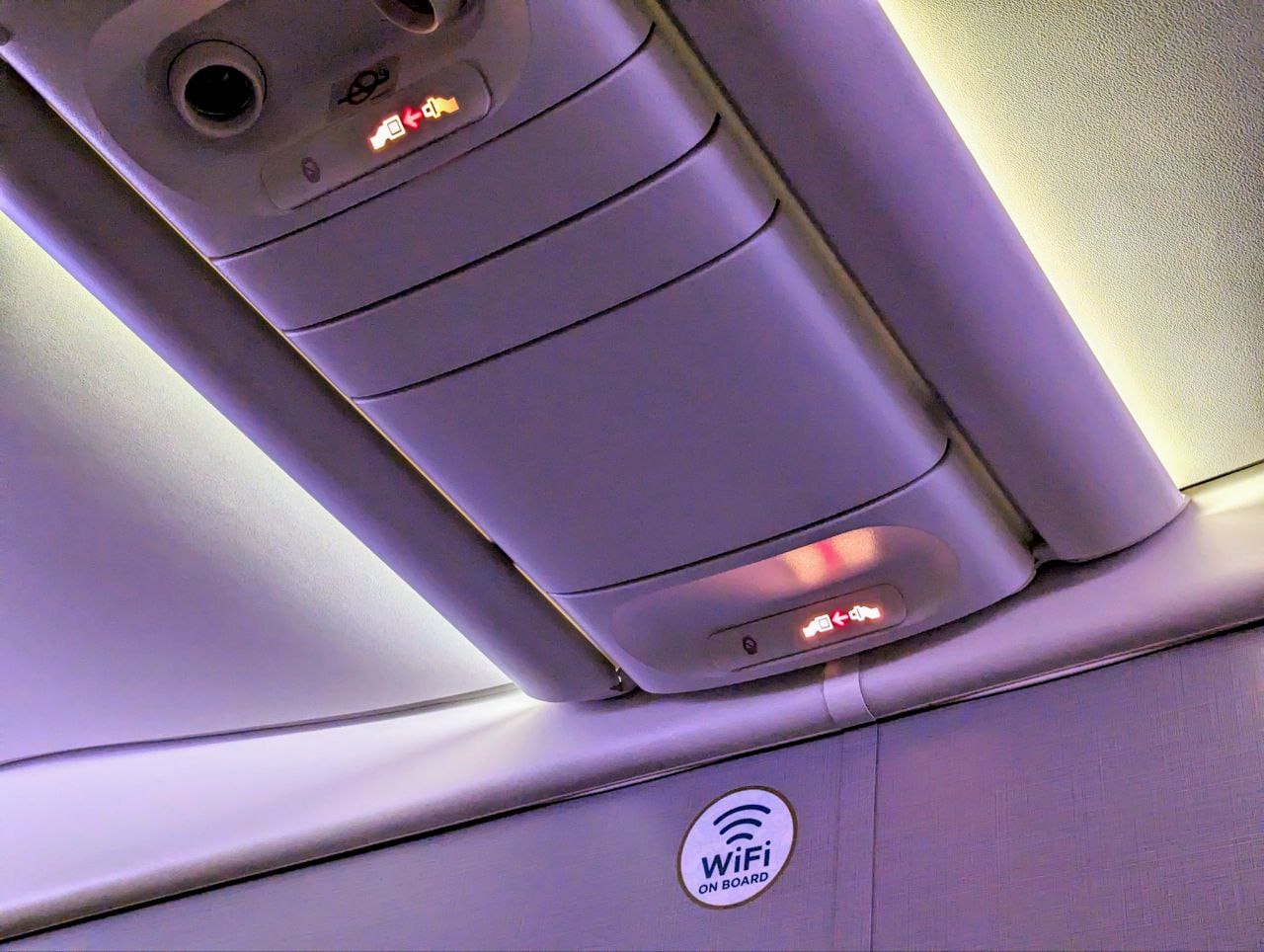I’m sure everyone is familiar by now with the tragic incident involving SQ321, where severe clear-air turbulence resulted in the death of one passenger and injuries to 71 more. This is the first fatal aviation accident for Singapore Airlines since the crash of SQ006 in 2000, and my heart goes out to all those affected.
Now, there’s already enough coverage out there about the incident itself so I’m not going to weigh in further on that- except to say that it’s somewhat annoying to read so many media outlets breathlessly describing the descent from 37,000 to 31,000 feet as a plunge. While I don’t mean to discount how terrifying the ordeal must have been for everyone on board, the change in altitude was in fact a standard, controlled descent at a regular rate, probably done to escape the area of turbulence.
That aside, what I do want to address are the modified service routines following this incident, which I experienced yesterday on a Singapore Airlines flight. You may very well encounter these in the days and weeks to come, so here’s what to expect.
|
Note: I reached out to Singapore Airlines for a comment on the modified cabin service routines, and received the following from a spokesperson:
|
Singapore Airlines modifies cabin service routines

I flew back home from Paris to Singapore on SQ335 yesterday, and during the pre-departure welcome, the inflight supervisor (IFS) told me that Singapore Airlines had modified its cabin service routines in light of the SQ321 incident.
The first change is that cabin crew must now be seated and belted in whenever the seatbelt sign goes on, as opposed to previously where they would only suspend hot drinks service, but continue with all other activities unless the pilot deemed the turbulence severe enough for the crew to be seated as well.

The second change — which may be particular to my flight — is that the second meal was served at the mid-point, instead of the usual 2.5 hours before landing. The idea behind this is that the weather closer to Singapore can be more unpredictable, and because of the requirement that cabin crew are seated whenever the seatbelt sign goes on, there may not be sufficient time to complete the service otherwise.

So on my flight, lunch was served shortly after departure from Paris, and then several hours later, breakfast was served with six hours to go till our 6.20 a.m landing in Singapore. It was a little odd to eat two meals with a relatively short gap between them, though I later came to appreciate the opportunity for uninterrupted rest, since the cabin lights remained off all the way until 35 minutes before landing.
Apart from that it was a pretty standard flight, and when walking through the cabin, I could see that everyone was taking a much more serious stance towards belting up even when the seatbelt sign was off, which can only be a good thing!
From my interactions with the crew, it seems the reaction to the new SOPs was mixed. On the one hand, they agreed that safety should of course be paramount. On the other, the new rule can be potentially disruptive to their workflow, and may result in them having to complete more work in a shorter amount of time.
Also, it did seem like there was quite a bit of confusion regarding when the second meal should be served, which is understandable given that this policy has just come into place. For instance, I was initially told by the IFS that the second meal would be served three hours prior to landing, before a cabin-wide announcement subsequently updated that to mid-flight.
Now, I can guess that some may feel like this is a knee-jerk reaction, since what happened on SQ321 was a black swan event that could have happened to any airline, at any point in time. In that sense, flying is no more or no less dangerous than it was a few days ago, so why should everything change?
But over on the MileChat, someone gave the analogy of a safety pause, which I think is quite apt. In the same way that the MOM (Ministry of Manpower, for those of you living outside of Singapore) might order a work stoppage following a major incident involving loss of life, this doesn’t necessarily imply that there’s anything wrong with the SOPs. Rather, it gives the airline some breathing space to assess what’s happened, and make calibrations that strike a balance between crew safety and service experience so that everyone can have confidence in the SOPs when they’re eventually reinstated.
For my part, I think most people would understand that there’s turbulence, and then there’s turbulence. Cabin crew consist of able-bodied individuals who are trained to safely carry out service in a mildly-unstable environment. On the other hand, the passenger mix comprises all sorts, including children and those with physical infirmities who should certainly not be moving about the cabin when any kind of bumpiness can be expected.
So having different sets of rules for crew and passengers is by no means a commentary on whose safety is more important, but rather the ability and training of the individuals concerned. Therefore, I don’t believe the current measures will be anything other than temporary- though someone pointed out on the MileChat that it’s apparently SOP on Chinese airlines for crew and passengers to observe the same seatbelt sign rules, which I was unaware of.
The other thing I’d say is that if the idea is to avoid potentially unpredictable weather closer to Singapore, I can understand the need to start the meal service much earlier for the Economy and Premium Economy cabins, where there’s a lot more passengers to be fed. But for the less dense First and Business Class cabins, there might be more leeway to do things closer to the original timeline.
Ultimately, this feels like something that will need to be decided on a case by case basis, depending on the pilot’s assessment of the expected weather en route. It’s certainly not an option on shorter regional flights anyway, where the meal will necessarily have to be served closer to Singapore.
Conclusion
Singapore Airlines has implemented some new SOPs for its cabin service following the SQ321 turbulence incident. The main change is that cabin crew are now required to be seated whenever the seatbelt sign is on, and that can have a knock-on effect on meal service timings, which on my flight was brought forward to the mid-point instead.
I understand these modifications may not suit everyone’s onboard routines, but it’s important to appreciate that the situation right now is fluid, and for what it’s worth, these restrictions are likely to be only temporary. I think we can all agree that the safety of the cabin crew is a lot more important than regular champagne refills!
If you’re flying in the next few days or weeks, do share any changes you’ve observed to the service routines.





While I was on ANA flying back to Singapore crew there also observed the same seat belt signs as the passengers.
lights on 35mins before landing would be a much welcome change after a long red eye really. especially with children.
1) Turbulences have been a reality of flying since day 1.
2) With technology today, turbulences are much more predictable. A flight today versus a flight 10 years ago, there is much less interruption of a flight.
3) The factors to be considered for the safety of cabin crew have been the same before and after SQ321. One single event should not trigger a complete change of SOP without proper analysis.
4) Changing meal times by hours is a knee-jerk reaction. This is not based on any fact or risk.
thank you for your wise words SMK77, I skip breakfast and thus less fazed, but the point about serving breakfast up to 6 hours prior to landing is completely absurd.
How to talk to headless chickens? No ears!
I flew on SQ319 from Heathrow to Singapore on the evening of 21st London time (landed in Singapore yesterday evening Singapore time). It was the immediate next SQ LON-SIN flight after news of SQ321 broke out (although there might have been snother flight that took off around the time or right before the news broke out).
Nothing was mentioned about the incident before or during the flight but I noticed the captain went into more detail about turbulence during the pre flight announcement, specifically mentioning about clear air turbulence being expected. Although buckling up when seatbelt sign was off was still “recommended” as per usual (thought they would have used stronger language).
Flight was generally smooth but halfway through the first in flight meal the seatbelt sign went on. So yep this was a bit unusual as you said as the meal service was suspended and the crew had to be buckled up. Captain mentioned that there was light to moderate turbulence expected for the next 15 to 20 minutes around the entire region so they couldn’t go around it – thought it was quite unusual for such level of detail to be divulged. After in flight service resumed they forgot (?) to serve desserts to slower eaters like me so I didn’t get to eat my ice cream.
My second meal was served unusually late though – not earlier like you mentioned. We were scheduled to land around 5pm but the second meal was only served at around 3.30pm. Thought this was highly unusual as on my flight from SIN to LON they served the second meal 4 to 5 hours before landing. I’m guessing they wanted to avoid serving meals until the point they were past the Andaman Sea? Seatbelt sign was turned on right for 15mins before second meal service too (which I guess contributed to the delay) but there wasn’t much turbulence. Funnily enough felt more turbulence while eating my second meal but the seatbelt sign didn’t come on – guess they had to finish serving the meals regardless.
Compared to my SIN-LON flight, there was barely any queue for the toilets though. Didn’t see anyone hanging around the cabin stretching either.
Let’s say if we fly from Singapore to Jakarta especially in J class, the meal service will be super rushed. If kena turbulence, then some of the pax seated at the very back no need to eat already…… 🤔
Last September – Rome to Singapore – meal service timing was exactly as you described a very early second meal, not so long after the first meal. We assumed due to turbulence over Bay of Bengal/Andaman Sea, but it was as smooth as silk.
I think the mean issue is that the Bay of Bengal / Andaman Islands is notoriously known for air turbulence and any flights passing through that area have a higher-than-normal risk. It’s just unfortunate that the area is just 2-3 hours from Singapore and hence it’s best to avoid serving meals at that time.
I fly every couple of weeks on that route and there is barely any turbulence, so I find this whole hype around turbulence a bit odd. Also, even if climate change will bring about more turbulence, at the same time pilots are now equipped with live weather updates, as opposed to be only informed from their on-board (limited) radar. Summary: more turbulence, but way more information to avoid them, hence safer.
I always experience turbulence over the bay of Bengal. I don’t recall ever flying back to SG from Europe without experiencing mild to moderate turbulence during those 3 hours between India and Singapore
Munich to Singapore 22 May landed 23 May (today) announcement was to “respect” the seatbelt signs 🙂 and yes during turbulence over the Andaman sea the crew were told to be seated and all service suspended. I was expecting meal to be earlier but it seemed the standard time of 2+h before arrival.
It is extremely rare to have an in-flight turbulence result in death, which happened to the 73-year-old senior British man who had cardiac issues, according to health officials. I guess this was one of the rare moments of fatal turbulence. But, the pilots did well in diverting the aircraft and landing it safely in Bangkok (Suvarnabhumi) to allow the injured to receive whatever healthcare treatment necessary.
Also, I think it will take some time for 9V-SWM to return to service following this incident as it will require internal repairs and disinfection works to be done. My heart goes out to the family of the 73-year-old senior British man and may those who are injured recover quickly and well.
yeah it’ll be interesting to see how long 9V-SWM remains out of action. the photos of the cabin look quite bad, though I have little to no engineering knowledge and can’t say whether that’s the kind of thing you just pop back into place or what.
I can’t disagree with you on that. Because someone died on board, disinfection works will also have to be carried out during the repairs. 9V-SWM looks alright externally, but it is the inside that needs extensive repair works. I have heard of other aircraft suffering internal damage following extreme turbulence (but without fatalities), like Qantas flight QF 072 from SIN TO PER in 2008. The Airbus A330-300 involved, VH-QPA, was repaired and returned to service after the incident.
This is an important update from Singapore Airlines. Safety always comes first, and it’s reassuring to see the airline taking proactive measures following the turbulence incident. Thanks for keeping us informed about the changes in cabin service routines.
Their protocols have worked well since it’s inception but suddenly not anymore after the first incident in over 50 years of flying.
Having cabin crew seated when the seat belt light is on introduces other safety issues, such as them no longer being able to do safety checks and clearing meal trays prior to landing and denying them rest during rest times (because they have to complete unfinished work).
Most telling though is that no other airline has followed suit and neither has FAA made such recommendations. It will only be a matter of time before the complaints of non-service get loud enough and profit margins get hit hard enough that level-headedness gets knocked back into the senses of the executives making such a knee jerk decision.
There is a risk in everything we do and it is always a fine line finding a balance between safety and service. Swinging to the extreme in reaction to an incident is not it. If Singapore Airlines deems that flying is now too risky, then maybe they should exit the industry.
https://www.reuters.com/graphics/SINGAPOREAIRLINES-THAILAND/movaqnmeava/
For scoot, the cabin crew take their seats when the seatbelt sign is on too, which differs from sq surprisingly.
With regards to crew suspending service when seatbelt sign is switched on, I feel it’s more of a knee jerk reaction. Not saying their safety is not important, but they are also well taken care off because the pilots will tell them to suspend service if need be, so it’s not a case of crew working no matter what. Moreover, meal service could still go on for everyone except economy, given that galley carts aren’t necessary needed for those classes, but again in a safety time out, safety should be maximised until they regroup.
SQ and Scoot have different safety policies. Scoot does not allow headsets during take off and landing while SQ does.
I think it is a wise temporary move to have the crew be seated and belted up – just like the passengers – when the seatbelt sign is on. However, would exception be made if someone presses the button for assistance / service?
Adding to Aaron’s article re SQ modified protocols, I’m having the same experience now on Milan – Singapore. Crew are serving breakfast with over 5 hours to go until landing, around 3.5 hours after the first meal was served.